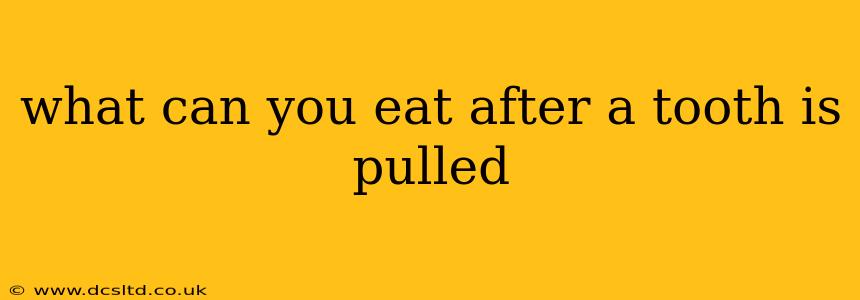What Can You Eat After a Tooth is Pulled? A Guide to Post-Extraction Diet
Having a tooth pulled can be a bit unsettling, and knowing what you can eat afterward is a top priority. The healing process is crucial, and your diet plays a significant role in ensuring a smooth recovery. This guide will walk you through what's safe to eat after an extraction, addressing common concerns and questions.
Important Note: Always follow your dentist's specific instructions. Recovery times and dietary recommendations can vary based on the complexity of the extraction and individual circumstances.
What are the immediate dietary restrictions after a tooth extraction?
Immediately following a tooth extraction, your dentist will likely recommend avoiding anything that could dislodge the blood clot forming in the extraction site. This clot is vital for proper healing. This means:
- No straws: The sucking action can dislodge the clot.
- No smoking: Smoking reduces blood flow and hinders healing, increasing the risk of dry socket.
- No spitting: Again, this can dislodge the clot.
- No hot food or drinks: These can increase bleeding and discomfort.
What foods are best to eat after a tooth extraction?
The first 24 hours are the most critical. Focus on soft foods that require minimal chewing and won't irritate the extraction site. Good options include:
- Yogurt: Provides protein and probiotics, beneficial for overall health and healing.
- Applesauce: Easy to swallow and digest.
- Mashed potatoes: A classic comfort food, soft and gentle on the gums.
- Oatmeal: A nutritious and soothing option.
- Scrambled eggs: High in protein, supporting tissue repair.
- Smoothies: Blend fruits, vegetables, and yogurt for a nutritious and easy-to-consume meal. Avoid anything with seeds or tough fibers.
- Pudding: A simple and comforting option.
What foods should I avoid after a tooth extraction?
For the first few days, avoid:
- Hard foods: Anything that requires vigorous chewing, such as nuts, chips, hard candies, and raw vegetables.
- Spicy foods: These can irritate the sensitive extraction site.
- Acidic foods: Citrus fruits and juices can cause discomfort.
- Foods that require a lot of chewing: This includes tough meats, popcorn, and bread crusts.
How long should I stick to a soft food diet after a tooth extraction?
Most people can gradually reintroduce more solid foods after a few days, but it's essential to listen to your body. If you experience discomfort, stick with softer foods. Completely healing can take several weeks, so a gradual transition to a normal diet is recommended.
Can I eat solid foods after a few days?
Yes, after the initial 24-48 hours, you can slowly begin to incorporate softer solid foods into your diet. Start with easily chewed items and gradually work your way back to your normal diet as comfort allows. If you experience any pain or discomfort, revert to softer foods.
What if I develop a dry socket?
A dry socket is a painful complication where the blood clot is dislodged from the extraction site. If you experience severe pain, a bad taste, or visible bone in the socket, contact your dentist immediately. They can provide appropriate treatment.
What are some nutritious options for a post-extraction diet?
Prioritizing nutrition during recovery is key. Include plenty of protein (for tissue repair), vitamins, and minerals in your diet. Focus on nutrient-rich soft foods like smoothies packed with fruits and vegetables or protein-rich yogurt.
Remember, every individual's healing process is different. Always follow your dentist's advice and listen to your body. By carefully selecting your foods in the days following a tooth extraction, you can promote comfortable and efficient healing.
